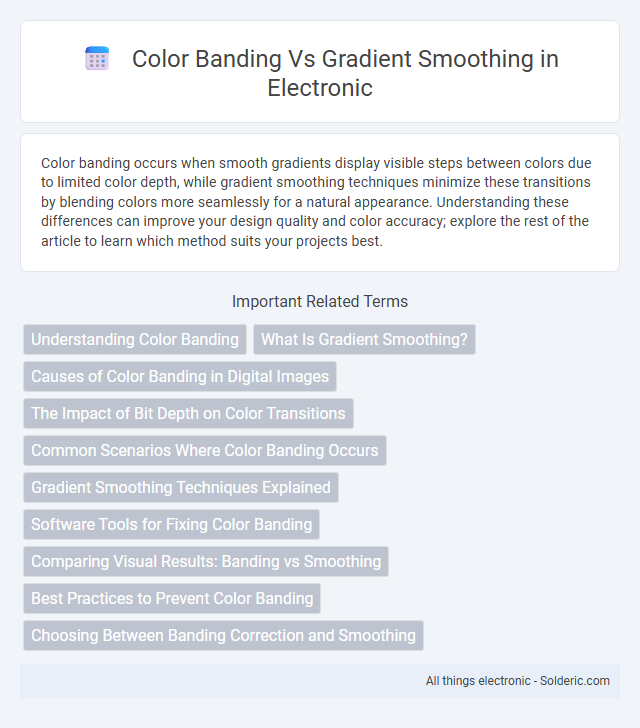Color banding occurs when smooth gradients display visible steps between colors due to limited color depth, while gradient smoothing techniques minimize these transitions by blending colors more seamlessly for a natural appearance. Understanding these differences can improve your design quality and color accuracy; explore the rest of the article to learn which method suits your projects best.
Comparison Table
| Feature | Color Banding | Gradient Smoothing |
|---|---|---|
| Definition | Visible steps or bands between colors in gradients | Technique to reduce color banding by blending colors smoothly |
| Cause | Limited color depth or poor color interpolation | Advanced interpolation and dithering methods |
| Visual Impact | Harsh lines; less natural gradients | Smooth transitions; natural look |
| Use Case | Unintended artifact in images or videos | Enhances image/video quality and user experience |
| Common Techniques | N/A (problem) | Dithering, higher bit-depth color, anti-aliasing |
Understanding Color Banding
Color banding occurs when smooth gradients display visible steps or bands instead of a seamless transition, often due to limited color depth or low bit-depth displays. This phenomenon is especially noticeable in digital images with subtle color changes, such as skies or shadows, where insufficient color information prevents a fluid gradient. Gradient smoothing techniques counteract color banding by increasing color interpolation and bit depth, producing more natural, visually appealing transitions.
What Is Gradient Smoothing?
Gradient smoothing is a digital image processing technique that reduces color banding by blending adjacent color shades to create a seamless transition in gradients. It minimizes harsh lines and visible steps between color tones, enhancing visual quality especially in digital art and photography. Effective gradient smoothing relies on advanced algorithms such as dithering or noise addition to achieve a natural and smooth gradient appearance.
Causes of Color Banding in Digital Images
Color banding in digital images occurs primarily due to limited color depth, where insufficient bits per channel create abrupt transitions between shades instead of smooth color gradients. The reduced tonal range causes visible steps or bands in areas that should display subtle shifts, often exacerbated by compression artifacts or improper dithering techniques. Understanding these causes helps you adjust settings like bit depth and enable gradient smoothing to achieve more natural and visually appealing images.
The Impact of Bit Depth on Color Transitions
Higher bit depth significantly reduces color banding by increasing the number of available color shades, resulting in smoother gradient transitions and more natural images. Low bit depth images have fewer shades, which causes abrupt changes and visible bands in gradients, while gradient smoothing techniques attempt to minimize these artifacts through dithering or blending algorithms. Your visual experience improves markedly as higher bit depths enable finer color gradations, eliminating distracting color bands in digital displays and graphics.
Common Scenarios Where Color Banding Occurs
Color banding commonly occurs in digital images with limited color depth, such as 8-bit displays or compressed JPEG files, where smooth gradients are essential. It is frequently visible in skies, shadows, and background gradients of video games, digital art, and low-bit-depth videos. Gradient smoothing techniques help reduce these visible bands by blending color transitions more seamlessly in these scenarios.
Gradient Smoothing Techniques Explained
Gradient smoothing techniques reduce color banding by introducing subtle variations in pixel color values, creating a seamless transition between shades. Methods such as dithering scatter noise throughout the gradient to mask abrupt color changes, while interpolation algorithms optimize color blending across pixels. These approaches enhance visual quality in digital images, minimizing artifacts and improving gradient fluidity on displays with limited color depth.
Software Tools for Fixing Color Banding
Software tools like Adobe Photoshop and Affinity Photo offer advanced gradient smoothing features that help reduce color banding by applying noise and dithering techniques. Specialized plugins such as Gradient Smoother or Noise Ninja provide precise control over gradient transitions, minimizing visible bands in your digital images. Using these tools, you can enhance your images significantly, ensuring smooth, natural-looking gradients without harsh edges or color shifts.
Comparing Visual Results: Banding vs Smoothing
Color banding manifests as distinct, harsh lines between color transitions, creating an unnatural and pixelated appearance that disrupts visual continuity. Gradient smoothing reduces these abrupt shifts by blending hues seamlessly, resulting in a more natural, fluid gradient with enhanced depth and realism. Your images will appear more polished and vibrant when gradient smoothing is applied, eliminating distracting visual artifacts common with color banding.
Best Practices to Prevent Color Banding
To prevent color banding in digital images and gradients, use higher bit depth settings such as 16-bit or 32-bit per channel, which provide smoother color transitions by increasing the number of available color tones. Applying dithering techniques introduces controlled noise to break up visible bands and create a more natural gradient appearance. Ensuring proper calibration of monitors and utilizing software with advanced gradient smoothing algorithms also enhances the visual quality by minimizing abrupt color shifts.
Choosing Between Banding Correction and Smoothing
Choosing between color banding correction and gradient smoothing depends on the specific visual issue and display context. Color banding correction targets abrupt transitions in limited color palettes by increasing bit depth or applying dithering, ensuring smoother gradients in digital images or video. Your decision should consider performance impact and visual fidelity, as gradient smoothing often softens transitions but may introduce blur or reduce detail.
Color Banding vs Gradient Smoothing Infographic

 solderic.com
solderic.com